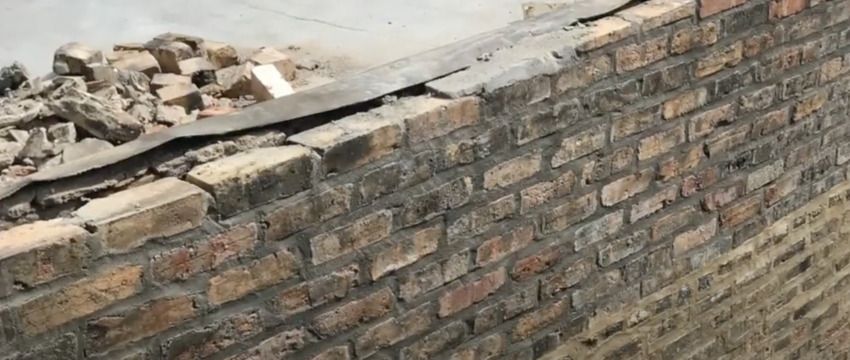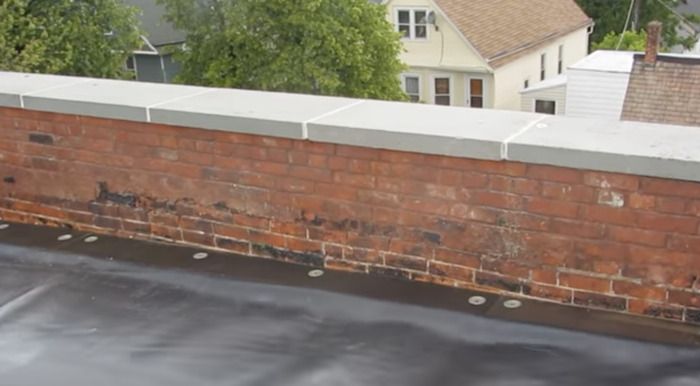Parapet Wall Repair in Chicago
Chicago Tuckpointing and Masonry is rated the #1 parapet wall repair company in Chicago when it comes to quality workmanship, using only the best material, and providing competitive pricing. We’re a
masonry company that takes tremendous pride in Chicago’s long history of quality and artistic masonry work. We strive to restore the original historic integrity with each project we work on. To us, we consider masonry a form of art extending to all brick, stone, and concrete work. If you’re in need of getting your parapet wall repaired then please give us a call for a free, competitive estimate!
What Is A Parapet Wall?
Parapet walls are low walls built along the edge of the roof, terrace, or balcony and plays a vital role in the safety of it’s occupants. Centuries ago, parapet walls were originally constructed with the intent of defending buildings from military attack. Today, we no longer have those same concerns, but Chicago buildings still have parapet walls used for adornment, guard rails, concealing rooftop equipment, reducing wind loads on the roof, and to prevent the spread of fires.
Parapet walls can be constructed from metal and wood, but the most common material used are brick, concrete and cement. This is the most prevalent material found on parapet walls in the Chicagoland area.
Get a 100% Free Estimate
What Type of Damage Can Occur?
Parapet walls are constantly at work defending your building from the elements, harsh winds, and sub-freezing temperatures. When nature fights back, over time it can degrade the structural integrity of the wall allowing water to leak into your building causing water to penetrate between bricks causing mortar
joints to spall and crack. If this continues over the course of many years, eventually the wall will start to buckle and eventually cave. Since fall, winter and spring can bring freezing rain, the constant force of the wind can push cold rain to find it’s way between any cracks and crevices in the mortar. As the rain freezes it expands causing further cracks in the mortar joints. This is the main way deterioration occurs in your parapet walls.
If you suspect that your parapet walls are structurally compromised, or are in need of attention in any way, have our experts at Chicago Tuckpointing and Masonry to properly assess the situation and provide a competitive estimate to bring the parapet wall back to it’s original status. Having a parapet wall that goes unattended can be very dangerous and cause severe injury and damage.
Here are a few things to look for if you suspect your wall needs the attention of a professional mason:
- Large gaps between bricks and mortar joints
- Easily penetrable by water
- Cracking or loose bricks
- Fragments of brick or mortar laying on the ground next to the wall
- Bowing or buckling of the wall

How are parapet walls repaired?
Repairing a parapet wall is a lengthy and involved process that goes through several stages. Assuming the parapet wall has gone through significant deterioration and needs to be rebuilt, we first properly prepare the work area by applying tarps, plywood, and erecting scaffolding as necessary. Once the prep work has been done, we begin with dismantling the current structure by removing the existing flashing and coping along with taking down the inner and outer course of bricks until we reach the sound level that is flush with the roof.
The deteriorated wall has now been completely removed and we can begin the rebuild of the new parapet wall. Layer by layer we reconstruct the wall to the height in the drawings and ultimately finish the top of the wall with either clay tiles or flashing. We’ll never leave the workspace a mess so all the excess material will always be properly cleaned and put away or disposed of and your roof will once again be able to be enjoyed.
How Much Does It Cost To Repair A Parapet Wall?
Repair/rebuild costs for a parapet wall can range anywhere between $20-$40 per square foot depending on the extent of work that needs to be performed.
We understand this is a wide range, but here are a few factors that affect the pricing:
- What is the scope of the project? Can the wall be repaired or does it need to be rebuilt?
- What is the overall lineal foot of the parapet wall?
- How many courses (or internal and external layers)?
- How tall is the building
- How accessible is it to transport material
- Type and style of copings used.
Having work done to your parapet wall could be a large financial commitment, and we try to make our pricing as affordable as possible. If it’s not financially feasible for your to get your wall completely rebuilt, we have had success in temporarily repairing a wall so that the homeowner can sort out their finances until they can commit to getting a new one rebuilt. If you are looking for a professional to assess your parapet wall, please give us a call and we can provide a 100% free estimate!
Are Parapet Walls Load Bearing?
No, parapet walls are not load bearing. They are free standing and extend upward passed the roofline. From a structural standpoint, they are not intended to provide any extra support. Their purpose is more so to prevent serious updraft during windy days where the force of the wind can literally tear a roof off. To prevent such events from taking place, parapet walls are constructed with multiple courses and to their intended heights to protect and extend the life of the roof.
How Do You Waterproof A Parapet Wall?
Parapet walls have a lot of exposure to the elements, particularly since all sides are essentially “uncovered”, but ensuring that your wall is properly sealed off from water is critical to prevent it from premature crumbling. Water is extremely destructive so we want to avoid it penetrating the wall at all costs.
To take proper measures, we cover the wall with a waterproofing membrane that keeps water from penetrating the masonry and keeps our roofs dry. There are several membranes available on the market, but dressing the membrane to the edge of the wall and terminating it with a roof edge trim is one way to do it, or it can be done prior to capping the wall.
In addition to the membrane, we ensure that proper copings are installed so that water does not run along the edge of the wall. The more water runs along the wall, the more damage the sitting water will cause in the long run and the more expensive the repairs will be. As mentioned before, properly waterproofing a wall is critical!


